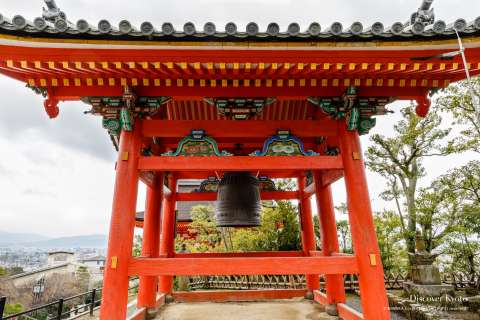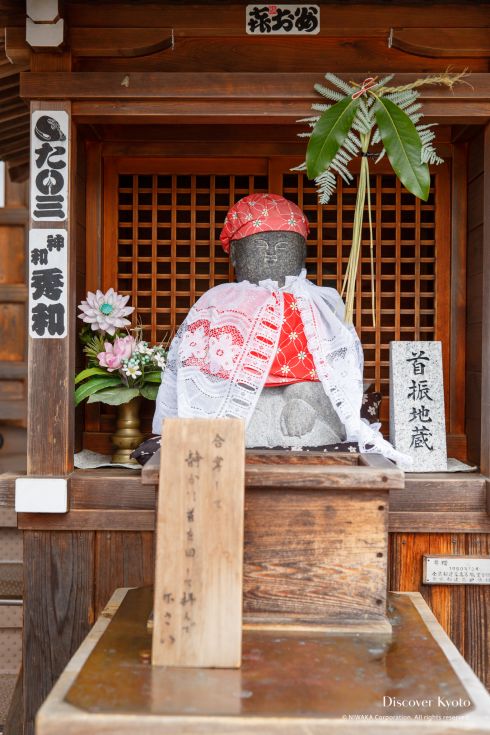Kiyomizu-dera|清水寺
Overview

Situated in the eastern Higashiyama area, Kiyomizu-dera is one of the most famous and celebrated temples in Kyoto. The temple was founded in 778 AD and contains buildings from the 17th century, including a main hall designated as a National Treasure. The temple’s wooden stage is undoubtedly what the temple is most famous for, offering an outstanding panoramic view of Kyoto rising out of a sea of maples. Drink the sacred water filled with good karma at the Otowa no Taki waterfall, wish for a loving relationship at the Jishu Shrine, venture into the “womb of the bodhisattva” tunnel and admire the numerous examples of beautiful architecture… There are countless ways you can enjoy Kiyomizu-dera.
Kiyomizu-dera temple is currently undergoing renovations on the main hall and stage area, but visitors are still permitted to enter the hall. Construction is expected to be completed in spring 2021. (Photos displayed on this page were taken in 2014).
The temple’s wooden stage is undoubtedly what the temple is most famous for, offering an outstanding panoramic view of Kyoto rising out of a sea of maples.
Features
Butai (Kiyomizu’s Wooden Stage)

Kiyomizu-dera’s most famous aspect is its wooden stage complex, made of 168 pillars. This structure was built using a rather special method: 12-meter high keyaki (Japanese Zelkova) pillars made from thick, centuries-old trees and a floor made of 410 cypress boards was assembled and installed without using a single nail, instead relying on locking wooden joints. The stage is popular with tourists all year round, offering a beautiful view no matter the season. The main hall of the Kiyomizu-dera temple complex houses small statues of the eleven-faced and thousand-armed incarnation of the Buddhist divinity Kannon and is connected to the butai, which was created as a stage for dedications and offerings. The Japanese expression “to jump off the stage at Kiyomizu” is used in the same way we would say “take the plunge” in English.
Three Story Pagoda

The three story pagoda at Kiyomizu-dera is one of the tallest of its kind in Japan, standing at 31 meters high. The current structure dates from a reconstruction carried out in 1633, when its original red coloring was also restored. Though you can see traditional onigawara tiles with demonic faces on them when looking at the roof, on the southeastern corner you can see a dragon regarded as a god of water that protects the structure against fire.
Bell Tower

The temple’s colorful bell tower was constructed in 1596. If you look closer, you can see beautiful chrysanthemum flowers carved above the fly brace of the tower. The bell tower was restored in 1999, when the beautiful vermilion color was enhanced. Though in the past these sorts of bells were used to direct the monks during the day, now it’s most famously rung on New Year’s Eve, when the bell is rung 108 times to symbolize the 108 earthly desires Buddhism acknowledges must be overcome.
Otowa no Taki (Otowa Waterfall)

This temple was named for the pure water that flows from the Otowa no Taki waterfall, with kiyomizu from the temple's name translating to “pure water”. It is said that this water possesses the power to extend one’s life and fulfill one’s wishes, and you can take a long-handled ladle and drink from one of the channels yourself!
Tainai Meguri
Before you enter the main temple you will come across a hall called the Zuigu-dō, which houses the Tainai Meguri. Without giving away too much, this is one of those interesting, “only in Japan” experiences. If you’re interested, pay the 100 yen admission fee and walk down the stairs into the pitch black tunnel. Going into the darkness, in fact, symbolizes walking into the womb of a female bodhisattva, and coming out of it back into the light symbolizes being reborn again. If you’re not afraid of the dark, this is something that most tourists overlook that you really should try!
Sannenzaka
The Sannenzaka shopping street is steep, but it’s definitely worth the walk for a shopper. It’s the perfect place to buy gifts for your family and friends, and for yourself as well, of course. It has a very vibrant atmosphere with both sides of the street lined with shops selling sweets, handicrafts, interesting foods such as black sesame ice cream, and Kiyomizu area’s finest pottery, called “Kiyomizu-yaki”. Sannenzaka is also a food sampler’s heaven, with many shops handing out free samples in front of their stores. Kiyomizu-dera temple and the shops here have a mutual beneficial relationship, with the shop owners volunteering their time and making donations to the temple that brings them so many customers.
Kubi Furi Jizō

Located outside the entrance gate of Kiyomizu-dera sits a jizō (Kshitigarbha) statue. At first glance he looks like an ordinary stone figure, but this statue is a special one that is said to grant your wishes. So, how does it work? After making an offering, you’ll need to make your wish. Once you’ve done that, turn the jizō’s head 360 degrees. It is said that if you make a wish regarding a love interest and turn his head towards the direction that person lives, it will bring you good luck. Not just magical, the jizō is also very fashionable and wears many different coordinated outfits throughout the year. What will he be wearing when you visit him?
Seasonal Light-ups

Kiyomizu-dera is one of a few temples that offers yearly light-up events, usually coinciding with the Higashiyama Hanatouro event, cherry blossom season, autumn, and other special occasions. During these periods you can enter the temple after dark to enjoy the trees and buildings of the temple expertly lit-up to showcase their beauty, or use the opportunity to squeeze in a bit more sight-seeing, since temples and shrines usually close before dark. Check the “Events” section for dates!
History
Founded in 778 in the early Heian period by the sacred Otowa Waterfall before Kyoto became the capital city, the temple was originally affiliated with the Hossō sect of Buddhism and considered a branch temple of Kōfuku-ji in Nara. The Hossō sect is one of the longest surviving sects in Japan that flourished when Nara was the capital of the nation, and it survives in Japan today despite dying out in China and Korea.
The temple’s founding abbot was the esoteric monk Enchin (known earlier in life as Kenshin), who in 778 dreamed that a divinity instructed him to make his way up the Kizugawa River to find a fountain of purest water. He arrived at a waterfall at the foot of Mt. Otowa, where he met a Buddhist ascetic named Gyōei Koji. The hermit gave him a piece of sacred wood, out of which Enchin carved a statue of Kannon Bosatsu before enshrining it in Gyōei Koji’s simple hut.
A few years later the famous general Sakanoue no Tamuramaro (758 – 811) headed into the Higashiyama mountains to hunt deer in order to pray for his sick wife’s recovery. After killing a deer he met Enchin, receiving a lecture from the monk about the sanctity of all life and the mercy of the compassionate Kannon. So moved and filled with guilt for killing the deer, Tamuramaro became a devoted follower of Kannon and thereafter raised a hall to keep the statue within; this hall is what would grow to become Kiyomizu-dera.
Over the centuries, the temple buildings were lost to fire multiple times, and the current complex consists primarily of reconstructions carried out from 1631 to 1633 by order of the third Tokugawa Shogun, Iemitsu.
In 1965, Kiyomizu-dera parted ways with the mainstream Hossō sect under the leadership of Onishi Ryōkei, who established independence from Kōfuku-ji and founded the independent Kita-Hossō (North Hossō) sect.
In 1994, Kiyomizu-dera was officially declared a UNESCO World Heritage Site as part of the Historic Monuments of Ancient Kyoto (Kyoto, Uji and Otsu Cities).
Events
January 1st – 7th | Shushō-e |
|---|---|
February | Setsubun Ritual |
February 15th | Nehan-e |
March | Spring Light-up |
March | Higashiyama Hanatouro Light-up |
March 14th – 15th | Seiryū-e (Blue Dragon Festival) |
April 3rd | Seiryū-e (Blue Dragon Festival) |
August | Obon Festivities |
August | Thousand Days’ Pilgrimage |
August | Summer Light-up |
September | Higan-e |
September 14th – 15th | Seiryū-e (Blue Dragon Festival) |
November – December | Autumn Light-up |
December 31st | Ringing of the New Year’s Bell |
Access
Address
〒605-0862 京都府京都市東山区清水1丁目294
| TEL | 075-551-1234 |
| FAX | 075-551-1287 |
| WEB | http://www.kiyomizudera.or.jp/lang/01.html |
Admission
- General Admission: ¥400
- Junior High School, Primary School: ¥200
Hours
- General Admission: 06:00 – 18:00, depending on the season
- Closed: No closing days
Transportation
- From JR Kyoto Station ⇒ City Bus Route 206 or 100 ⇒ Gojōzaka Bus Stop ⇒ 10 minutes walking
- From JR Kyoto Station ⇒ Kyoto Bus Route 18 ⇒ Higashiyama Gojō Bus Stop ⇒ 10 minutes walking
- By Keihan Line ⇒ Kiyomizu Gojō Station ⇒ 25 minutes walking
- From Shijō Kawaramachi (Hankyū Line Kyoto Kawaramachi Station or Keihan Line Gion Shijō Station) ⇒ City Bus Route 207 bound for Tōfukuji/Kujō Shako or Keihan Bus Route 83, 85, 87, or 88 ⇒ Kiyomizu-michi Bus Stop ⇒ 10 minutes walking
Gallery
-




 +18
+18
